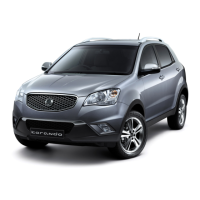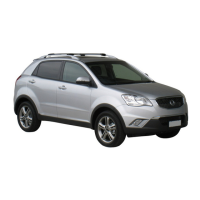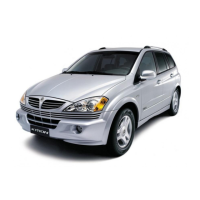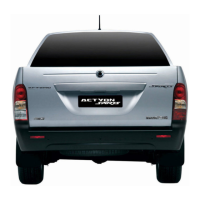Do you have a question about the SSANGYONG Korando and is the answer not in the manual?
Explains the manual's intent, safety information, and recommendations for vehicle operation.
Guidelines for the first few hundred kilometers to ensure good performance, economy, and long life.
Steps to take before entering the car, including checking windows, tires, and controls.
Adjusting seating, mirrors, fastening seat belts, and checking gauges and warning lights.
Information on provided keys, key number plate, and the electronic immobilization system.
Details on using the keyless entry system to lock/unlock doors and activate the anti-theft alarm.
How to lock and unlock doors using the key and the central locking system.
How to adjust front and rear seats, head restraints, and seat belts for safety.
Guidelines for proper seat belt use, precautions, and child restraint systems.
Guidance on recommended fuels, methanol usage, and fueling from containers.
Explanation of ignition switch positions (LOCK, ACC, ON, START) and associated warnings.
Steps for starting the engine, including manual and automatic transmissions, and diesel glow indicators.
Explains automatic transmission operation, drive ranges, and safety precautions.
How to operate the 4WD system, including shifting between 2H, 4H, and 4L modes.
Information on disc brakes, performance loss, and driving with wet brakes.
Explanation of Anti-lock Brake System (ABS) and Traction Control System (TCS) functions.
How to apply and release the parking brake, and precautions when parking.
Identification of major controls and instruments on the dashboard for manual and automatic transmissions.
Detailed explanation of the instrument cluster gauges and warning/indicator lights for diesel engines.
Functions and readings of the speedometer, odometer, trip odometer, and tachometer.
Explanation of various warning lights such as low fuel, oil pressure, and malfunction indicators.
Meaning of brake system, ABS, and EBD warning lights and their implications.
Explanation of seat belt, airbag, turn signal, and hazard warning lights.
How to engage, set, accelerate, decelerate, and cancel cruise control.
Explanation of what a turbocharger is and its benefits for engine performance and efficiency.
Precautions for preventive maintenance and inspection of the turbocharger system.
Location and specifications of the spare wheel, jack, and associated tools.
Step-by-step guide on how to safely change a flat tyre, including safety precautions.
Instructions and safety precautions for jump starting a vehicle with jumper cables.
Guidelines for towing a disabled vehicle, including emergency towing and tips.
General safety precautions to follow when performing inspection or maintenance on the vehicle.
Procedure for checking engine oil level, contamination, and oil/filter change intervals.
How to check coolant level, concentration, and precautions for overheating.
Procedure for checking brake and clutch fluid levels and related safety warnings.
Information on tyre inflation pressure, condition, and replacement recommendations.
Advice on selecting cleaning agents and proper techniques for interior care and safety belts.
Methods for washing, polishing, waxing, and cleaning exterior parts like wheels and bright metal.
Strategies for protecting the vehicle from corrosion and maintaining the underbody.
Recommended lubricants, capacities, and classifications for various vehicle systems.
Key dimensions, weights, and specifications for different vehicle models.
Specifications for maximum speed, gradeability, turning radius, and gear ratios.
Detailed engine specifications including displacement, bore/stroke, compression ratio, and power.
Explains the manual's intent, safety information, and recommendations for vehicle operation.
Guidelines for the first few hundred kilometers to ensure good performance, economy, and long life.
Steps to take before entering the car, including checking windows, tires, and controls.
Adjusting seating, mirrors, fastening seat belts, and checking gauges and warning lights.
Information on provided keys, key number plate, and the electronic immobilization system.
Details on using the keyless entry system to lock/unlock doors and activate the anti-theft alarm.
How to lock and unlock doors using the key and the central locking system.
How to adjust front and rear seats, head restraints, and seat belts for safety.
Guidelines for proper seat belt use, precautions, and child restraint systems.
Guidance on recommended fuels, methanol usage, and fueling from containers.
Explanation of ignition switch positions (LOCK, ACC, ON, START) and associated warnings.
Steps for starting the engine, including manual and automatic transmissions, and diesel glow indicators.
Explains automatic transmission operation, drive ranges, and safety precautions.
How to operate the 4WD system, including shifting between 2H, 4H, and 4L modes.
Information on disc brakes, performance loss, and driving with wet brakes.
Explanation of Anti-lock Brake System (ABS) and Traction Control System (TCS) functions.
How to apply and release the parking brake, and precautions when parking.
Identification of major controls and instruments on the dashboard for manual and automatic transmissions.
Detailed explanation of the instrument cluster gauges and warning/indicator lights for diesel engines.
Functions and readings of the speedometer, odometer, trip odometer, and tachometer.
Explanation of various warning lights such as low fuel, oil pressure, and malfunction indicators.
Meaning of brake system, ABS, and EBD warning lights and their implications.
Explanation of seat belt, airbag, turn signal, and hazard warning lights.
How to engage, set, accelerate, decelerate, and cancel cruise control.
Explanation of what a turbocharger is and its benefits for engine performance and efficiency.
Precautions for preventive maintenance and inspection of the turbocharger system.
Location and specifications of the spare wheel, jack, and associated tools.
Step-by-step guide on how to safely change a flat tyre, including safety precautions.
Instructions and safety precautions for jump starting a vehicle with jumper cables.
Guidelines for towing a disabled vehicle, including emergency towing and tips.
General safety precautions to follow when performing inspection or maintenance on the vehicle.
Procedure for checking engine oil level, contamination, and oil/filter change intervals.
How to check coolant level, concentration, and precautions for overheating.
Procedure for checking brake and clutch fluid levels and related safety warnings.
Information on tyre inflation pressure, condition, and replacement recommendations.
Advice on selecting cleaning agents and proper techniques for interior care and safety belts.
Methods for washing, polishing, waxing, and cleaning exterior parts like wheels and bright metal.
Strategies for protecting the vehicle from corrosion and maintaining the underbody.
Recommended lubricants, capacities, and classifications for various vehicle systems.
Key dimensions, weights, and specifications for different vehicle models.
Specifications for maximum speed, gradeability, turning radius, and gear ratios.
Detailed engine specifications including displacement, bore/stroke, compression ratio, and power.
| Brand | SSANGYONG |
|---|---|
| Model | Korando |
| Category | Automobile |
| Language | English |












